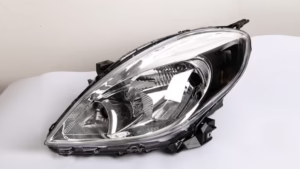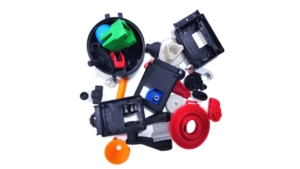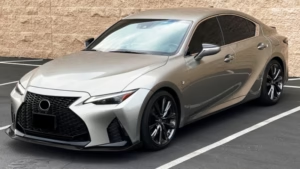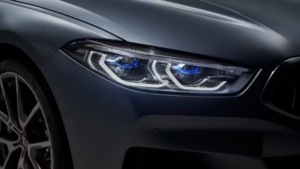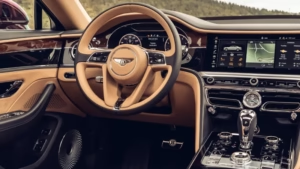Automotive exterior lighting systems are more than accessories; they are integral to driver safety, communication with other road users, and even vehicle branding. This guide explores the essential components, key functions, types, materials, development processes, design considerations, and future trends shaping the automotive exterior lighting landscape.
What is Automotive Exterior Lighting?
Automotive exterior lighting refers to all lighting systems installed on the outside of a vehicle to fulfill purposes such as illuminating the road, signaling driver intent, increasing vehicle visibility, and enhancing aesthetic appeal. These exterior car lights include everything from headlights and taillights to side markers and specialty signal lamps. The importance of these systems is underscored by strict legal regulations worldwide governing light color, intensity, placement, and performance.
Main Components of Automotive Exterior Lighting
Bulbs or Light Sources: It is responsible for generating the visible light. Modern exterior vehicle lighting employs a wide range of light sources, including traditional halogen bulbs, high-intensity discharge (HID) lamps such as Xenon, and energy-efficient light-emitting diodes (LEDs).
Reflectors: Reflectors are designed to capture and direct the light emitted by the bulb, shaping the beam pattern to meet illumination or signaling requirements. Depending on the function, reflectors may be made from polished metals or specialized automotive plastic material, tailored to optimize light distribution.
Lenses: Lenses cover the light source and reflector assembly, protecting components and modifying light distribution. Made typically from polycarbonate or glass materials, lenses may have various textures or patterns. For example, headlight lenses are engineered for clarity, durability, and precision.
Housing: The housing encloses and supports the light assembly, safeguarding all internal components against environmental hazards such as water, dust, and mechanical shocks.
Custom Car Light Housing Solutions
Key Functions of Automotive Exterior Lighting
The functions of exterior vehicle lighting extend well beyond simple illumination. Their primary purposes can be categorized as follows:
- Illumination: The most fundamental role, exterior lighting assists drivers in seeing the road ahead, especially in low-light or adverse weather conditions.
- Signaling: To enhance safety, turn signals, brake lights, and reverse lights communicate a driver’s intentions. A flashing amber signal or a glowing red brake light conveys critical information to others on the road.
- Visibility: Daytime running lights (DRLs), side markers, and position lights make vehicles visible, reducing collision risks, especially in low-light conditions.
- Aesthetics: Beyond utility, exterior car lights define a vehicle’s character. Unique shapes, colors, and lighting signatures can identify automotive brands and models instantly, contributing to the vehicle’s road presence.
Types of Automotive Exterior Lighting
Automotive exterior lighting systems are categorized by their placement and purpose, each serving a specific role:
Front Exterior Lighting
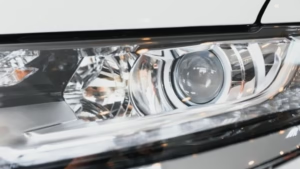
Headlights: Headlights provide both low beam (dipped beam) and high beam (main beam) functions. Low beams provide sufficient road illumination without dazzling oncoming traffic. High beams provide intense, broad light for long-distance visibility.
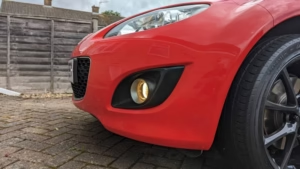
Fog Lights: Mounted low on the front bumper, fog lights generate a wide, short-range beam to improve vision in adverse weather conditions such as fog, rain, and snow.
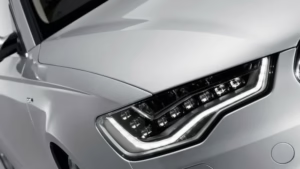
Daytime Running Lights (DRLs): The DRLs are automatically activated while the vehicle is running to enhance daytime visibility of the vehicle by other road users.
Turn Signals: Positioned on the front corners, turn signals indicate the driver’s intention to change direction or lanes with a blinking light.
Rear Exterior Lighting
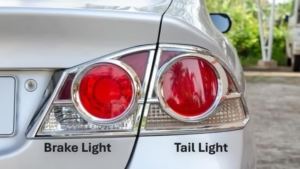
Tail Lights: Automotive tail lights are at the rear, tail lights provide visibility from behind, and activate when headlights or parking lights are on, generally emitting red light.
Brake Lights: Brighter than regular tail lights, brake lights illuminate upon pressing the brake pedal to warn vehicles behind of deceleration.
Turn Signals: Rear turn indicators communicate directional changes with flashing yellow or red lights, depending on regional standards.
Reverse Lights: These white lights activate when the vehicle is in reverse gear, aiding visibility for the driver and alerting pedestrians and nearby traffic.
Side Exterior Lighting
Side Marker Lights: Positioned on the side of the vehicle, these lights highlight vehicle width and presence, enhancing lateral visibility.
Reflectors: Built into side surfaces and bumpers, reflectors passively reflect ambient light to increase the vehicle’s visibility at night, even when the lights are off.
Side Turn Signals: They are often integrated into side mirrors, signaling turns from the side profile.
Other Lights:
License Plate Lights: Illuminate the license plate for legal compliance.
Emergency Lighting: Flashing beacons for emergency vehicles, though less common in consumer cars.
Common Materials in Automotive Exterior Lighting
The materials used in automotive exterior lighting are chosen for durability, performance, and cost-effectiveness:
Light Sources Materials
The choice of material for light sources depends on the bulb type. Halogen bulbs use a tungsten filament encased in quartz glass. Xenon (HID) lights rely on a gas-filled chamber with electrodes. LEDs use semiconductor materials like gallium nitride or indium gallium nitride.
Reflectors Materials
- Polished Metals: Aluminum is widely used because of its excellent reflectivity, lightweight nature, and heat dissipation properties.
- Plated Plastics: Plastics such as polycarbonate or ABS can be coated with a thin metallic layer (usually aluminum) through vacuum metalizing, producing lightweight and cost-effective reflectors with good optical performance.
Lenses Materials
- Polycarbonate (PC): The most common lens material, polycarbonate offers high impact resistance, light weight, excellent optical clarity, and UV resistance. Its flexibility enables complex lens geometries and fine texture for beam shaping.
- Polymethyl Methacrylate (PMMA): Also known as acrylic, PMMA provides excellent light transmission and weather resistance. It is highly color stable, making it popular for tail lights and decorative lenses.
- Glass: Still used in some premium or classic vehicle models due to superior scratch resistance and outstanding optical clarity, though heavier and more fragile than plastics.
Housing Materials
- Acrylonitrile Butadiene Styrene (ABS ): A robust thermoplastic commonly used for housing due to its strength, toughness, and good molding properties. ABS is cost-effective and offers decent heat resistance.
- Polycarbonate (PC) blends: These blends improve impact resistance and thermal stability for housings subject to harsh environments.
- Aluminum: Employed in higher-end or performance lighting housings, aluminum efficiently dissipates heat generated by LEDs or other light sources, enhancing reliability.
- Steel: Utilized for structural support or mounting brackets within complex assemblies, steel offers great mechanical strength.
- Sealants (Silicone, Rubber): Used extensively to seal housings, protect internal components from moisture, dust, and vibration, and maintain long-term durability.
Development Process and Manufacturing Techniques of Automotive Exterior Lighting
Creating automotive exterior lighting involves a sophisticated process, blending innovation with precision:
Development Process of Automotive Exterior Lighting
- Optical Design and Simulation: Engineers use advanced software, such as Synopsys LucidShape or Ansys SPEOS, to model light distribution and beam patterns.
- Prototype Production and Testing: Based on the design, prototypes are manufactured for bench testing. These prototypes undergo testing for photometric performance, thermal management, vibration resistance, and environmental durability.
- Regulatory Compliance: Designs are tested against regional standards to ensure light intensity, color, and placement meet legal requirements.
- Integration and Validation: Lighting assemblies are integrated into the vehicle platform and further tested in real-world and simulated driving conditions.
- Refinement and Finalization: Feedback from validation stages leads to design refinements. Once finalized, tooling for mass production is prepared.
Manufacturing Techniques of Automotive Exterior Lighting
Common mass production manufacturing processes include:
- Injection Molding: Used for producing polycarbonate lenses and ABS or polypropylene housings, injection molding ensures high precision and consistency. Molten plastic is injected into molds to create complex shapes with tight tolerances.
- Precision Coating: Reflectors are coated with reflective materials, like aluminum or chromium, using vacuum metallization. This process creates a mirror-like finish, maximizing light output while maintaining cost-effectiveness. Lenses are coated with anti-scratch, UV-protective, and anti-reflective layers to enhance durability and optical clarity.
- Automated Assembly: Light sources (e.g., LEDs, halogen bulbs) are integrated with reflectors, lenses, and housings via automated assembly lines. Automation ensures accuracy and reduces defects, especially for high-volume production.
- Thermal Management Integration: For LED systems, heat sinks or cooling fans are incorporated to dissipate heat, preserving performance and longevity. These components are often made of aluminum or thermal-conductive plastics.
Design Considerations for Automotive Exterior Lighting
Designing automotive exterior lighting requires balancing multiple factors:
Regulatory Compliance: Every exterior car light must meet strict legal requirements regarding light intensity, color, positioning, and beam shape to be road-legal and safe.
Durability and Reliability: Since exterior lighting is exposed to harsh weather, vibrations, and impacts, materials and assembly techniques must ensure long-term robustness.
Energy Efficiency: With rising environmental and sustainability concerns, light sources and system power consumption are optimized to reduce vehicle energy demands.
Thermal Management: LEDs generate heat, requiring heat sinks or cooling systems to maintain performance and longevity.
Aesthetics: Lighting designs align with brand identity, from minimalist DRLs to intricate LED patterns that scream luxury.
Integration with Vehicle Systems: Increasingly, exterior lighting works with sensors and control units to enable adaptive lighting technologies and vehicle communication.
Future Trends in Automotive Exterior Lighting
The future of automotive exterior lighting shines with intelligent, adaptive systems. Adaptive driving beams (ADBs) use sensors to optimize light distribution, while V2X communication enables lights to signal pedestrians and vehicles, supporting autonomous driving. OLEDs and laser lighting offer enhanced efficiency and design flexibility. Machine learning and digital simulations streamline design, delivering safer, more stylish exterior car lights.
Zhongren Supplies Customized Automotive Lighting Solutions
Zhongren supplies customized automotive exterior lighting solutions with professional manufacturing methods. Zhongren provides high-quality light housing and lens solutions that meet unique client needs.
